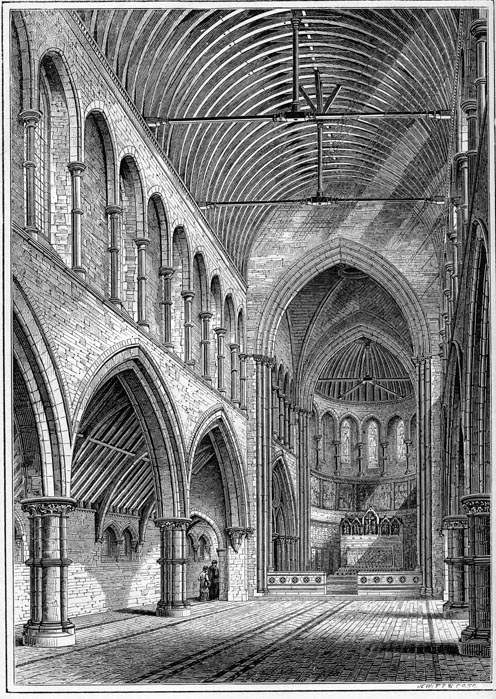|
St Andrew's Church, Plaistow
St Andrew's Church was a Church of England church on Barking Road in Plaistow, east London. It began as a small mission built in 1860 on Whitwell Road by St Mary's Church, Plaistow. A permanent church designed by James Brooks opened in 1870 on a site just south of the northern outfall sewer embankment and a separate parish assigned to it the following year. A large central crossing tower with a pyramidal spire was planned but only completed as far as the ridge of the nave roof. In 1903 the church opened the mission hall that later became St Cedd's Church, Canning Town - the mission district for it was split off from the parishes of St Andrew's and St Luke's. St Andrew's suffered heavy damage during the London Blitz but was extensively repaired after 1945. The building was Grade II listed in 1984 but is no longer an Anglican church, now housing offices and a UCKG Help Centre and with its chancel walled off. Its parish is now within the Parish of the Divine Compassion. In 2006, ... [...More Info...] [...Related Items...] OR: [Wikipedia] [Google] [Baidu] |
Church Of England
The Church of England (C of E) is the established Christian church in England and the mother church of the international Anglican Communion. It traces its history to the Christian church recorded as existing in the Roman province of Britain by the 3rd century and to the 6th-century Gregorian mission to Kent led by Augustine of Canterbury. The English church renounced papal authority in 1534 when Henry VIII failed to secure a papal annulment of his marriage to Catherine of Aragon. The English Reformation accelerated under Edward VI's regents, before a brief restoration of papal authority under Queen Mary I and King Philip. The Act of Supremacy 1558 renewed the breach, and the Elizabethan Settlement charted a course enabling the English church to describe itself as both Reformed and Catholic. In the earlier phase of the English Reformation there were both Roman Catholic martyrs and radical Protestant martyrs. The later phases saw the Penal Laws punish Ro ... [...More Info...] [...Related Items...] OR: [Wikipedia] [Google] [Baidu] |
Plaistow, Newham
Plaistow ( or ) is a suburban town in East London, England, within the London Borough of Newham. It adjoins Upton Park to the north, East Ham to the east, Beckton to the south, Canning Town to the south-west and West Ham to the west. It was originally a ward in the parish of West Ham, hundred of Becontree, and part of the historic county of Essex. Since 1965, Plaistow has been part of the London Borough of Newham, a local government district of Greater London. The town forms the majority of the London E13 postcode district. Plaistow North and Plaistow South are two of the ten electoral wards making up the UK parliamentary constituency of West Ham. The main roads are the A112; Prince Regent Lane, Greengate Street, The Broadway, High Street and Plaistow Road, which is a former Roman road; and the A124 (Barking Road), which passes south west/ north east through Plaistow and past the former West Ham United football ground. Commercial and retail premises are on the A ... [...More Info...] [...Related Items...] OR: [Wikipedia] [Google] [Baidu] |
St Mary's Church, Plaistow
St Mary's Church is a Church of England church in Plaistow in the (East-) London Borough of Newham. With the three churches of St Matthias’, St Martin's, and St Philip and St James’, it now forms part of the Parish of the Divine Compassion. Its Victorian building, designed by Sir Arthur William Blomfield in 1890-1894, was demolished in 1976. They now worship in a smaller church built in 1981. It was built as a chapel of ease to All Saints Church, West Ham, then the only parish church in the area. It was promoted to a parish in its own right in 1844. The site was granted by Sir John H Pelly and the church designed in the neo-Gothic style influenced by the late Perpendicular style by Thomas Curtis. Notable among its vicars was Thomas Given-Wilson, who raised is capacity to 1,000 through a comprehensive rebuild. The parish also built several mission churches - St Peter's, Upton Road (1880s), St Katherine's on Chapman Road (1891; replaced by a permanent church in 1894; ... [...More Info...] [...Related Items...] OR: [Wikipedia] [Google] [Baidu] |


